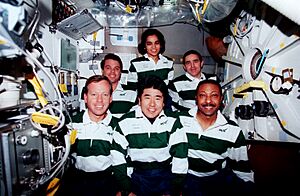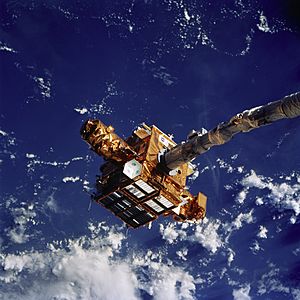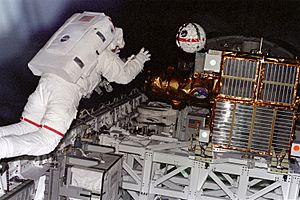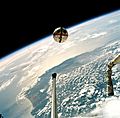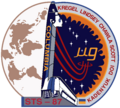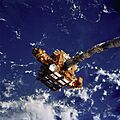STS-87 facts for kids
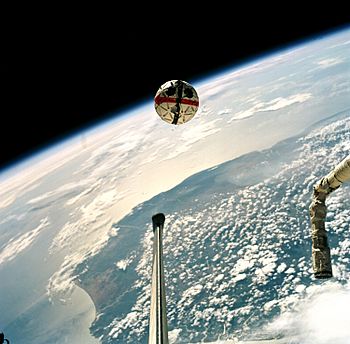
AERCam Sprint, one of the USMP-4 payloads, in flight above Columbia's payload bay
|
|
| Mission type | Microgravity research Technology development |
|---|---|
| Operator | NASA |
| Mission duration | 15 days, 16 hours, 35 minutes, 01 seconds |
| Distance travelled | 10,500,000 kilometres (6,500,000 mi) |
| Spacecraft properties | |
| Spacecraft | Space Shuttle Columbia |
| Landing mass | 102,717 kilograms (226,452 lb) |
| Payload mass | 4,451 kilograms (9,813 lb) |
| Crew | |
| Crew size | 6 |
| Members |
|
| Start of mission | |
| Launch date | 19 November 1997, 19:46 UTC |
| Launch site | Kennedy LC-39B |
| End of mission | |
| Landing date | 5 December 1997, 12:20 UTC |
| Landing site | Kennedy SLF Runway 33 |
| Orbital parameters | |
| Reference system | Geocentric |
| Regime | Low Earth |
| Perigee | 273 kilometres (170 mi) |
| Apogee | 279 kilometres (173 mi) |
| Inclination | 28.45 degrees |
| Period | 90.0 min |
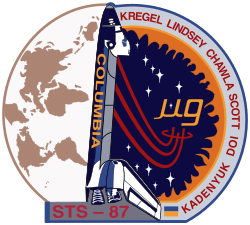 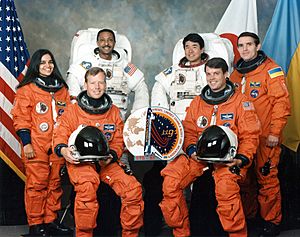 Left to right - in orange: Chawla, Lindsey, Kregel, Kadenyuk; in white: Scott, Doi |
|
STS-87 was a Space Shuttle mission launched from the Kennedy Space Center on November 19, 1997. It was the 88th flight of the Space Shuttle program. It was also the 24th flight for the Space Shuttle Columbia.
The main goals of this mission were to do science experiments. These experiments used the United States Microgravity Payload (USMP-4). The crew also performed two spacewalks, called EVAs. They also launched a special experiment called SPARTAN-201. This mission was special because it was the first time a spacewalk was done from Columbia. It was also the first spacewalk by a Japanese astronaut, Takao Doi.
Contents
- Meet the Astronauts: STS-87 Crew
- Mission Highlights: What Did STS-87 Do?
- United States Microgravity Payload (USMP-4)
- SPARTAN-201: Studying the Sun
- Isothermal Dendritic Growth Experiment (IDGE)
- Space Acceleration Measurement System (SAMS)
- Orbital Acceleration Research Experiment (OARE)
- Shuttle Ozone Limb Sounding Experiment (SOLSE)
- Loop Heat Pipe (LHP)
- Sodium Sulfur Battery Experiment (NaSBE)
- Collaborative Ukraine Experiment (CUE)
- Autonomous EVA Robotic Camera (AERCam Sprint)
- A Comic Character in Space
- Images for kids
Meet the Astronauts: STS-87 Crew
| Position | Astronaut | |
|---|---|---|
| Commander | Third spaceflight |
|
| Pilot | First spaceflight |
|
| Mission Specialist 1 | First spaceflight |
|
| Mission Specialist 2 | Second and last spaceflight |
|
| Mission Specialist 3 | First spaceflight |
|
| Payload Specialist 1 | Only spaceflight |
|
Backup Crew Members
| Position | Astronaut | |
|---|---|---|
| Payload Specialist 1 | Yaroslav Pustovyi First spaceflight |
|
Spacewalks: Exploring Outside the Shuttle
- Winston Scott and Takao Doi – Spacewalk 1
- Start Time: November 25, 1997 – 00:02 UTC
- End Time: November 25, 1997 – 07:45 UTC
- How Long: 7 hours, 43 minutes
- Winston Scott and Takao Doi – Spacewalk 2
- Start Time: December 3, 1997 – 09:09 UTC
- End Time: December 3, 1997 – 14:09 UTC
- How Long: 4 hours, 59 minutes
Mission Highlights: What Did STS-87 Do?
STS-87 carried many different science experiments. These included the United States Microgravity Payload (USMP-4). Other experiments were Spartan-201, and the Orbital Acceleration Research Experiment (OARE). There was also the Shuttle Ozone Limb Sensing Experiment (SOLSE). The mission also tested new technologies like the Loop Heat Pipe (LHP) and the Sodium Sulfur Battery Experiment (NaSBE).
The crew also worked with the Autonomous EVA Robotic Camera/Sprint (AERCam Sprint). Experiments inside the shuttle included the Middeck Glovebox Payload (MGBX). There was also the Collaborative Ukrainian Experiment (CUE).
United States Microgravity Payload (USMP-4)
The USMP-4 was a project to study microgravity. Microgravity is the condition where things seem weightless, like in space. This project used a special lab called Spacelab. The experiments were placed in the shuttle's cargo bay. The mission was longer than usual, which gave scientists more time to collect data.
SPARTAN-201: Studying the Sun
Spartan 201-04 was a small satellite. It was designed to study the Sun's outer atmosphere, called the solar corona. The satellite was released from the shuttle and then picked up later. Scientists wanted to learn why the solar corona is so hot. They also wanted to understand the solar wind, which comes from the corona.
Spartan had two main instruments. One was the Ultraviolet Coronal Spectrometer. The other was the White Light Coronagraph. These tools helped scientists see different parts of the Sun's corona. Spartan also had other experiments to test new technologies for future space missions.
Isothermal Dendritic Growth Experiment (IDGE)
The IDGE experiment studied how materials freeze, especially metals. When some materials freeze, they form tiny, tree-like shapes called dendrites. Scientists want to understand the size and shape of these dendrites. This is important because these shapes affect how strong or useful a material is.
Space Acceleration Measurement System (SAMS)
The SAMS was a system that measured tiny movements and vibrations on the shuttle. Even in space, there are small forces that can affect experiments. SAMS used special sensors called accelerometers. These sensors could detect very small changes in motion. The data from SAMS helped scientists understand how these tiny movements might affect their experiments, especially those studying microgravity.
Orbital Acceleration Research Experiment (OARE)
The OARE was another sensitive tool. It measured how much the shuttle was slowed down by the very thin air in space. This is called aerodynamic acceleration. Understanding this helps scientists predict how objects move in orbit. It also helps improve how we process materials in space.
Shuttle Ozone Limb Sounding Experiment (SOLSE)
The SOLSE experiment aimed to measure ozone in Earth's atmosphere. Ozone is a gas that protects us from harmful sunlight. Scientists wanted to see how ozone is spread out at different heights. This helps them understand changes in our atmosphere. SOLSE used a special camera technology to map the ozone.
Loop Heat Pipe (LHP)
The LHP was a test of a new way to manage heat in spacecraft. It used a liquid called ammonia to move heat around. This system can move a lot of heat over long distances. It works without any moving parts, using natural forces. This technology is important for keeping future satellites and spacecraft at the right temperature.
Sodium Sulfur Battery Experiment (NaSBE)
The NaSBE tested new types of batteries in space. These batteries use sodium and sulfur. They need to be heated to a very high temperature to work. This was the first time these batteries were tested in space. If successful, they could provide power for future space missions.
Collaborative Ukraine Experiment (CUE)
The CUE was a joint project between scientists from Ukraine and the United States. It studied how plants grow in microgravity. The experiment used a special plant growth facility. They grew turnip plants to see how they reacted to being in space. This research helps us understand how to grow food for long space missions.
Autonomous EVA Robotic Camera (AERCam Sprint)
The AERCam Sprint was a small, free-flying camera. It could move around outside the shuttle by itself. It was designed to help astronauts inspect the outside of spacecraft. The camera was shaped like a ball and covered in soft material. This was to prevent damage if it bumped into anything. Astronauts controlled it from inside the shuttle using a special joystick.
A Comic Character in Space
This mission had a fun first: a comic book character was created just for it! The character was named Starfire. It was designed to go into space and return safely. This idea came from a scientist who noticed an experiment's short name, ELF. He was a fan of the Elfquest comic series. He asked the creators to make a special logo for the experiment.
Images for kids



